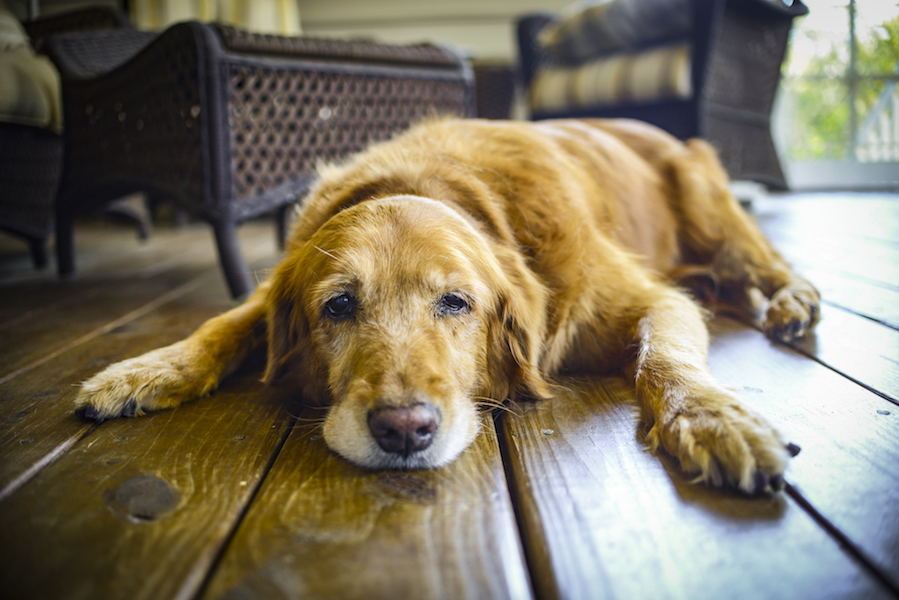Hypothyroidism in dogs
Hypothyroidism in dogs is a hormonal disorder that is frequently seen in our four-legged friends.
Since this disease can greatly deteriorate the quality of life of your pet, sometimes without you even realizing it, it is essential to learn how to recognize it in order to provide him with appropriate care. Because, although the disease is incurable, it is easily possible to control it very effectively for life to give back to your little doggie all his joy of living and keep him in good health!
What is hypothyroidism in dogs?
Hypothyroidism in dogs is a dysfunction of the thyroid gland, which is responsible for the production of hormones that are essential for the proper functioning of the metabolism. Hypothyroidism is, therefore, one of those mysterious hormonal or endocrine diseases that give veterinary medicine a hard time.
The reason for this is that the hormonal mechanisms of the dog's body are not yet fully understood, which can make some endocrine disorders particularly difficult to treat. Fortunately, this is not the case with hypothyroidism, which, although relatively unexplained, can be easily corrected.
The thyroid is a gland made up of two lobes that extend on either side of the trachea in the dog's throat. Under the control of the pituitary gland, which is located in the central nervous system, the thyroid gland produces three hormones that regulate the dog's metabolism: T3, T4 and calcitonin.
It is mainly the production of T4 that interests us here, since it is this one that will be synthesized by the liver to produce T3. T3 is the hormone of metabolism par excellence. It is the master of the orchestra, which sets the rhythm for all the organs, allowing, de facto, their synchronization and, in fine, the proper functioning of the entire body.
In case of hypothyroidism, the thyroid gland produces less hormones than expected. The opposite phenomenon is hyperthyroidism, and consists of an abnormally high production of hormones. While hyperthyroidism causes an increase in metabolic rate, hypothyroidism, which is what we are concerned with here, results in a slowdown.

Causes of hypothyroidism in dogs
The causes of hypothyroidism in dogs are not yet fully understood, but a distinction is made between secondary and primary pathologies. While primary hypothyroidism occurs due to local dysfunctions, secondary hypothyroidism is due to disorders of the pituitary gland in the brain, which is supposed to control the thyroid.
Primary hypothyroidism in dogs
Primary hypothyroidism in dogs is the most common. They represent, by far, the majority of all hypothyroidism diagnosed in our four-legged friends. Of these primary hypothyroidisms, the most common are lymphocytic thyroiditis and idiopathic thyroid atrophy, which are equally distributed in the canine population. Lymphocytic thyroiditis is a supposedly autoimmune disease, causing the destruction of the thyroid gland cells. By a mechanism that is still not well understood, the dog's antibodies, normally intended to protect its body against pathogens, attack its own cells.
A genetic factor is probably involved, as some breeds of dogs are clearly predisposed to this condition. This is the case for the Schnauzer and the Hovawart, and to a lesser extent for the Beagle, the Boxer, the Doberman, the Great Dane, the Poodle and the Dachshund.
Idiopathic thyroid atrophy is an equally poorly understood condition at present, which may be an evolution of lymphocytic thyroiditis, although the involvement of antibodies has not been demonstrated. This condition results in the destruction of thyroid cells, which are gradually replaced by fat cells that are non-functional and do not produce hormones. Idiopathic thyroid atrophy appears to be correlated with age, as dogs that are affected are significantly older than those with lymphocytic thyroiditis.
Secondary hypothyroidism in dogs
Secondary hypothyroidism in dogs is rare and accounts for less than 5% of all hypothyroidism in the canine population. It is primarily caused by a deficiency of THS, which is a disorder of the pituitary gland, which is responsible for the production of this hormone that stimulates the thyroid gland. In other words, the thyroid gland no longer receives the necessary signals to activate itself and therefore ceases to produce the precious T4 hormone, even though it is, at first glance, capable of doing so.
Eventually, the cells of the thyroid gland deteriorate from inactivity, resulting in primary hypothyroidism. Other rarer disorders can also cause secondary hypothyroidism in dogs, but at present seem to be anecdotal. Certain drug treatments could be involved, especially those prescribed for hyperthyroidism (antithyroid drugs).
Similarly, thyroid cancer tends to cause hyperthyroidism, but the treatments used to fight the disease can cause hypothyroidism. This is especially true of thyroid surgery and radioactive iodine. Iodine deficiencies, which are very rare in dogs, may occur in cases of severe malnutrition or undernutrition. The thyroid is a particularly iodine-intensive organ, since it uses it to synthesize T3 and T4, which are partly made up of iodine. This type of deficiency can not only hinder its functioning, but can also lead to an irreversible deterioration of its tissues.
Symptoms of hypothyroidism in dogs
Hypothyroidism in dogs is an insidious disease that tends to progress silently for years, at least in the eyes of the owner. In fact, the dog can feel the harmful effects of a slowed metabolism very early on. This phenomenon, which in its early stages causes fatigue and lack of energy, is difficult for the owner to see, as the dog cannot put into words what it is feeling.
For the dog suffering from a slowed metabolism, daily life can be relatively difficult and even exhausting, even when he does nothing. The visible symptoms of hypothyroidism, which will motivate the owner to consult a veterinarian, come later, as the thyroid gland deteriorates.
One of the most obvious symptoms of hypothyroidism in dogs is an uncontrollable weight gain. Unfortunately, few owners are aware of it, and most of them naturally - but wrongly - blame it on poor diet or overeating.
In reality, the metabolism of a dog with hypothyroidism is slowed down and unable to burn the calories it needs. At the same time, the appetite is no longer properly regulated and the dog eats less. In spite of everything, he puts on weight, which tends to make the owner go crazy.
No organ is spared by the slowing down of the metabolism. The dog's digestive system becomes lazy, making digestion less efficient, slower, more difficult, and even painful. This is because food stays in the digestive tract too long and tends to ferment, causing bloating and a feeling of heaviness.
Benign irritations of the digestive tract can occur, making the assimilation of nutrients all the more complex. Alternating moderate diarrhea and constipation are sometimes observed. The dog's skin and hair can be very marked by hypothyroidism because the cell cycle slows down, which no longer allows the cells to renew themselves as quickly as they should.
The appearance of the dog's coat deteriorates, and it is less thick, dull and brittle. The skin is dry, susceptible to infection and dandruff. The animal's body temperature drops, and the dog becomes very sensitive to cold. Its heart rate is slower, which causes exacerbated fatigue and intolerance to effort.

Treatment and prognosis of hypothyroidism in dogs
The treatment of hypothyroidism in dogs is exclusively hormonal. It does not cure hypothyroidism, but it does correct its deficiencies. The veterinarian will prescribe your dog a dose of synthetic hormones carefully calculated according to his weight. Once your pet's metabolism returns to normal, he will naturally begin to lose weight, and it will be necessary to adjust his treatment.
It is extremely important not to neglect the follow-up of your dog, because a treatment that is too high - or not high enough - can be the cause of many inconveniences. The prognosis for a properly treated dog is excellent, although it may take some time for the symptoms to disappear. Your four-legged friend will be able to live his or her life quite normally, and his or her longevity will not be shortened by the treatment or by the disease.
And best of all, it's an inexpensive treatment that anyone can give to their best canine friend. Without treatment, the prognosis of the dog is more reserved, because its organs, badly regulated, can suffer irreversible damage.
FAQ
How do I know if my dog has hypothyroidism?
The symptoms of hypothyroidism in dogs are not easy to detect, and the best way to diagnose the disease early is to give your dog a regular veterinary check-up. At first, the animal tends to be lackadaisical, tired, even intolerant of exercise and, above all, inexplicably fat. Eventually, when the disease is advanced, his coat becomes dull and sparse, his skin is dry, his reproductive cycle stops and his voice may change.
How is hypothyroidism in dogs treated?
Hypothyroidism in dogs can be treated with synthetic hormones, which replace the hormones that your dog's non-functioning thyroid should produce. A veterinary consultation is essential before implementing any treatment, as the synthetic hormones must be carefully measured against each dog's weight and blood tests. The treatment will then have to be followed for life, and carefully adjusted according to any variations in the dog's weight.
Which dogs are prone to hypothyroidism?
There are two breeds of dogs that are particularly prone to lymphocytic thyroiditis, one of the two most common diseases causing hypothyroidism in dogs: the Schnauzer and the Hovawart. Other breeds, including the Beagle, Boxer, Doberman, Great Dane, Poodle and Dachshund are also more common than others.
My dog has hypothyroidism, what should I do?
If you suspect your dog has hypothyroidism, it is essential to take him to a veterinarian who will perform a blood test to make an accurate diagnosis. Don't overlook this condition, as it can seriously affect your dog's quality of life without you even realizing it. Plus, treatment for hypothyroidism in dogs is very inexpensive and easy to do, so it's a shame to take it away from your furry friend.
Although hypothyroidism is common in dogs, it is still relatively unknown, both in its mechanisms and symptoms. Unexplained obesity is one of the most obvious clinical signs of the condition, but still too many owners confuse the condition with entirely different problems, such as unreasonable gluttony.
Although most of the early symptoms of the disease are almost undetectable to the novice handler, the dog does feel the effects of the disease, and can be deeply burdened by the slowing of his metabolism.
A regular veterinary check-up is the best way to diagnose and manage a possible thyroid disorder as soon as possible and give your dog the quality of life he deserves.

